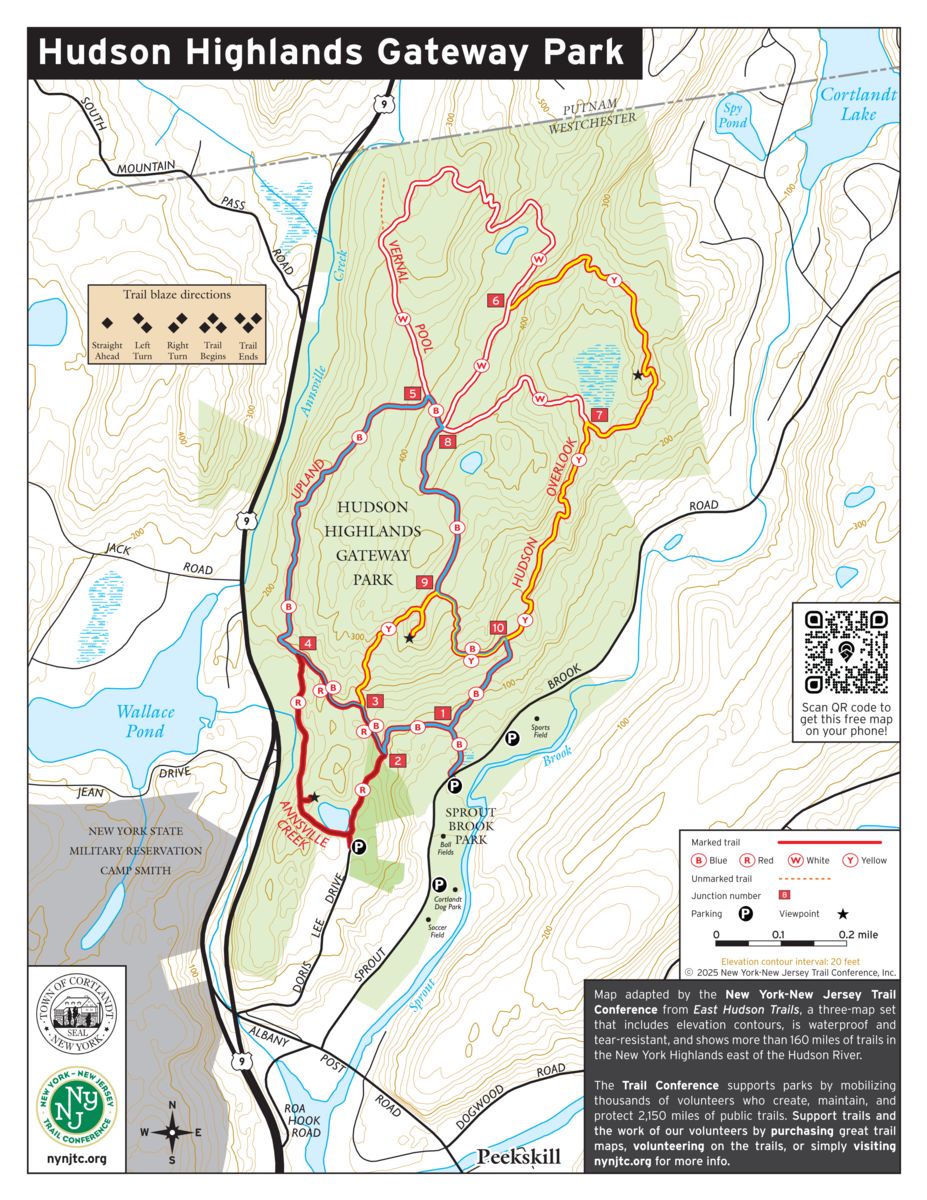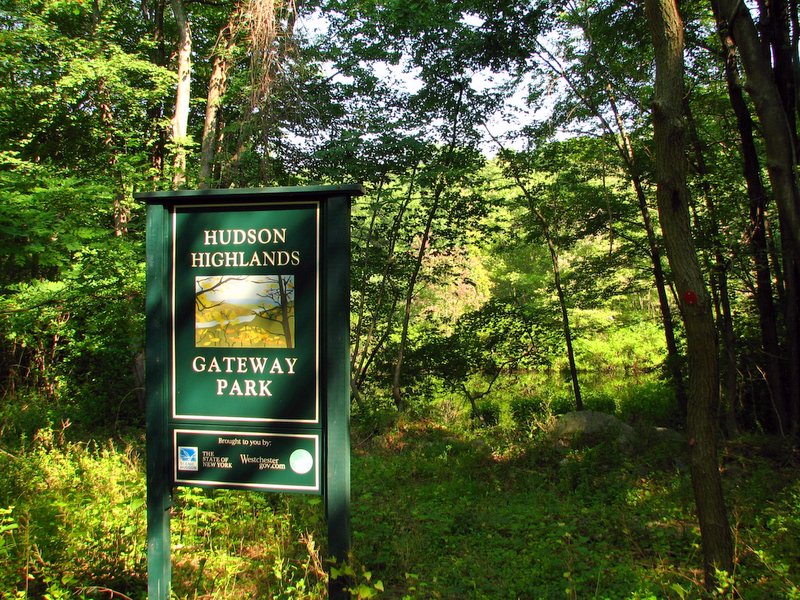Hudson Highlands Gateway Park
History of the Site
Hudson Highlands Gateway Park, 352 acres of woodlands, streams, steep slopes, exposed bedrock, and meadows, has been a site of much human and natural history.
During the Revolutionary War the hilltops were used to light signal fires to send messages to troops up and down the Hudson River and troops were stationed nearby, possibly in the park itself.
In the 19th century the hills were stripped clean of trees to feed the furnaces of the region’s Iron Foundries, such as the West Point Foundry in Cold Spring, which were a booming industry along the Hudson at the time.
From the late 1800s to about 1950 the park was used for farming, especially dairy farming. Much of the milk produced to make Horton’s Ice Cream came from here. One of the most recent past uses of the parkland can still be seen today on the eastern side of the park where a gravel mine operated as recently as the early 1970s.
As the active/commercial use of the park stopped, vegetation grew back and local residents started to use and value it for hiking, watching wildlife, and as open space in an area being quickly developed into homes, stores, and other businesses.
How the Park was Protected
Once the gravel mine closed, pressure to develop the property began to increase. First, a plan to build 1200 multifamily and individual houses was proposed but was defeated. Later, a 352-unit development was planned and it became clear permanent protection was needed or a valuable community resource would be lost.
In 1998 a coalition of more than 35 groups of homeowners associations, local community groups, governmental organizations, and several national and regional environmental organizations (led by Scenic Hudson) came together in a tale of collaboration, partnership, and effective use of public and private resources. The Coalition to Preserve the Hudson Highlands Gateway, as the group was called, worked to convince the developer to sell the property, and raise the $6 million needed to buy the property. The fundraising alone took over a year to accomplish.
In May of 2000, The Scenic Hudson Land Trust, Inc. purchased 203 acres of the park and the Town of Cortlandt and Westchester County purchased the remaining 149 acres. Ultimately, a conservation easement will be granted to Scenic Hudson by the Town and County, forever preserving the property as parkland and passive recreational use. Enjoy your time here, but please "take nothing but pictures, leave nothing but footprints."
Natural History of the Site
Hudson Highlands Gateway Park’s 352 acres encompass many different ecologically significant habitats. The Annsville Creek runs through the property providing stream and riparian habitats, which support brown and brook trout breeding as well as populations of wood duck. The park’s upland wetlands consist of vernal pools and wooded swamps that are crucial habitat for wood frogs, tree frogs, red-backed and two-lined salamanders. Several different snake species use the prominent, east-facing cliffs of the park to warm themselves in the sun.
Westchester County is in the Atlantic Flyway, one of three major bird migration corridors in the United States. Come spring, hundreds of thousands of birds fly over and often stop in the park. It is the diversity of habitats the park holds that draws them here. The relatively unfragmented forest of the park attracts species such as the scarlet tanager, ovenbird, and great-crested flycatcher. The former gravel mines and agricultural fields provide habitat for blue jays, catbirds, house wrens as well as hawks and owls that use these areas to hunt.
All of the ecological richness of the park is now yours to enjoy. To insure that the plants and animals that rely on this park are there for future generations, please do not touch, remove or in anyway disturb any of the plants or wildlife you may see.
Project Narrative
This project plan will recreate and enhance views of the Hudson River and provide opportunities for the public to experience the beauty, bio-diversity. and historic resources of Hudson Highlands Gateway Park.
The park encompasses 352 acres of unfragmented mature forest, on largely steep and rugged terrain, with bedrock outcrops and freshwater wetlands and vernal pools. At the Gateway begins the great sweep of the Highlands, an historic and ecologically significant swath of green hills that was the scene of many important events in the Revolutionary War.
-
Local Scenic Resources
-
Provide opportunities for the public to experience the beauty, bio-diversity. and historic resources of Hudson Highlands Gateway Park by
Developing scenic overlooks; with associated tree and brush clearing, restoring existing trails and creating new trails, constructing a parking lot, conducting an historic resource inventory; including archaeological field work, identifying artifacts and interpreting, providing informational signs and kiosks.
Protecting the Annsville Creek, a highly productive and sensitive trout stream which feeds into the Hudson River Estuary and the important link in the Highlands' chain of wildlife habitat and migration corridors;
Linking the views of The Hudson Highlands State Park and the Hudson River.
-
Relationship between the mission of the proposing organization and goals of the proposed program facility. As an integral component of the Park Management Agreement entered into between the Town of Cortlandt (“the Town”) and The Scenic Hudson Land Trust, Inc. A Land Use Plan was developed to provide the framework, scope of work, and schedule for the creation of improvements to the park.
-
Particular river environments upon which the initiative will focus; The Hudson River
-
Primary audience(s) for the initiative; The Public
-
Specific objectives of the proposed initiative, including as appropriate: conservation, educational or recreational outcomes; public information resources or services; sustainable river use or access improvements; water quality improvements.
The objectives are to conserve natural scenic resources, protect habitats and to promote public awareness of the Hudson. Our goal is to create and enhance views of the Hudson River, provide opportunities for the public to experience the beauty, bio-diversity. and historic resources of the park. We propose to develop scenic overlooks, restore existing trails and create new trails, construct a parking lot, conduct an historic resource inventory; including archaeological field work, curation of artifacts and interpretation, and provide informational signs and kiosks.
-
Previous, current and proposed uses of the property; the previous landowner planned to construct 352 homes on the site.
In July of 2000 the Town entered into an agreement with Scenic Hudson, and Westchester County to acquire the property. The site will be developed for passive recreation and education.
-
Relationship to other plans and the status of those plans - proposed, approved and adopted; In accordance with a Park Management Agreement entered into between the Town of Cortlandt (“the Town”) and The Scenic Hudson Land Trust, Inc. A Land Use Plan was developed to provide the framework, scope of work, and schedule for the creation of improvements to the park.
-
Describe any unique opportunity or special timing issue;
As specified, in the adopted Land Use Plan, as signified by the execution of the Park Management Agreement and Conservation Easement, the town shall carry out the following improvements in the 36 months. The parking area; At least two trail heads;
Hiking trails providing access to the higher elevations of the Park and to features of historic and ecological interest, and which link Sprout Brook Park to the Park; Signage, including that which recognizes the funders of the acquisition and others who participated in the creation of the Park.
-
Who will benefit and how are they involved; The Public.
-
Relationship to significant Hudson River resources;
The Annsville Creek, a highly productive and sensitive trout stream which feeds into the Hudson River Estuary runs southerly within the Gateway property from its northern border for about 4,000 feet with several tributaries from the west. The site provides a link with the Highlands' chain of wildlife habitat and migration corridors; and offers views of Hudson Highlands State Park and the Hudson River.
-
Current project status including permits and environmental review; The Metropolitan Conservation Alliance (MCA), a program of the Wildlife Conservation Society, is inof the process conducting an ecological inventory and analysis of the site.
-
Experience and qualifications of the applicant to undertake the planning or implementation agenda, including the names and backgrounds of the principal project managers and professional participants;
-
Identify the conservation benefit; .The recommended funding to make the necessary improvements as outlined in (9) will help provide opportunities for the public to experience the beauty, bio-diversity. and historic resources of Hudson Highlands Gateway Park.
-
For river access projects, clarify what constitutes public access. Is it open to the public without charge or restrictions? Is a fee charged for use? If yes, what is the fee? Are there restrictions on who has access, such as membership in an organization or a residency requirement? The Park shall be open to the general public without fee.
-
Assess project in relationship to evaluation criteria for appropriate category in Appendices C-G and provide details of how the project will meet these criteria.



